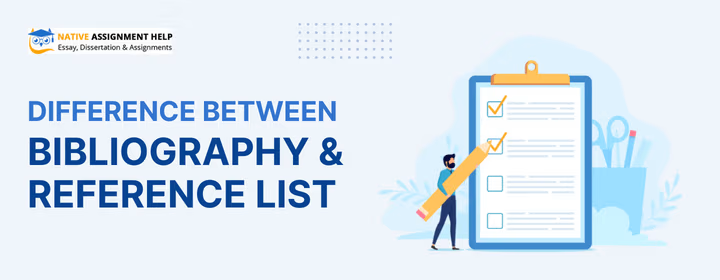Bibliography V/S Reference List: Clearing the Confusion for Learners
Learners often mull over the thought- “the difference between a bibliography and a reference list”, provoking them to seek clarification. This complication usually arises from the various needs of reference styles such as APA, MLA, and Chicago. All these styles have different rules regarding what to add to these lists, leading to thinking about which sources should be referenced. Furthermore, several students use "bibliography" and "reference list," replacing each other. They do not know that the bibliography highlights all references consulted, while a reference list comprises only those straightly cited in the article.
Such misunderstandings can arise from inadequate knowledge about citation practices during the education period. Moreover, tight deadlines and ineffective time management usually push students towards rushing through their assignments without a complete grasp of these concepts. This can further create hurdles in their learning. As an outcome, students might aspire to seek help from such online resources to clarify their doubts regarding the concepts. This can also help them to improve their writing proficiency and academic performance, aiming for boosted grades and more effective learning of citation practices.
What is a referencing List?
A referencing list is a collection of all the exact references you used in your content. It is mostly used in academic research papers where you need to let the readers know which sources inspired you to conduct research and helped in forming the foundation for your research.
A referencing list matches point to point-with citations that you mentioned inside your content. Through a referencing list, all the citations can be easily located throughout the content. A referencing list is majorly used in academic writing which helps track every detail related to a particular citation.
A referencing list is very important especially when you are writing assignments as a university student and using information from certain publications. It allows the provision of proper credit to the authors and creates a map to reach the original articles. A referencing list helps in maintaining students’ and authors' academic integrity with the usage of rightful practices.
If you are wondering what is the actual format of creating a reference list. Well, there is no fixed way as there are different referencing styles used, which are as follows:
- MLA - In this citation, you should include the author's surname and the page number.
- APA - The format of APA referencing includes the author's surname, date of publication and page number.
- Harward - Author’s surname and year of publication.
- MHRA - In this, a superscript number is attached with notes mentioned at the foot of the page. For this type of referencing you need to mention complete details of the source you used.
What is a Bibliography?
A bibliography is a more descriptive version of a referencing list. All the sources which inspire the research are mentioned. Even if the sources do not You don't have to include content from all the sources that you mention in the bibliography.
- Analytical: In this type of bibliography, new information related to sources is included in the writing of any book that is yet to be published. It can be further divided into textual, descriptive and historical types of bibliographies.
- Annotated: This kind of bibliography serves the purpose of creating an overview of what type of research was done while adding comments for each source used. It entails the value a particular source helped in answering the research question.
- Numerative: This type of bibliography is arranged in any specific order. Attributes like year and topic subject are used for deciding the position of the source in the list. The purpose of this type of bibliography is to help readers find any reference easily from a list of all the references.
In a bibliography, you need to mention the following things
- Author name
- Title of the publication
- Date of publication
- The place of publication of a book
- The publishing company of the book
- The volume number of the book
- The page number/s
What is the Difference between a Bibliography and a Reference List?
Although a bibliography and a reference list are very similar to each other, there are still many differences that make them different which are mentioned in the table given below:
| Criteria | Reference List | Bibliography |
| Purpose | It records all citations referenced directly in the content, leading readers to those exact works. | All sources consulted, even those not mentioned, provide a more general context for the study. |
| Source Type | Mainly includes primary sources employed in the research. | Includes primary and secondary citations, offering a complete overview of the topic. |
| Length & Intricacy | Generally shorter and simpler, concentrating on cited works. | Typically longer and intricate, containing a wider range of literature. |
| Citation Style | Usually tracks a detailed citation style (e.g., APA, MLA) for formatting citations. | May not align with a strict format; and can differ widely in style and format. |
| Use in Documents | Generally found in academic papers, hypotheses, and dissertations. | Usually appears in academic works like books, research reports, and literature reviews. |
| Additional Details | Gives complete citation information for each source, such as writer, title, and publication date. | May contain annotations or outlines of the works listed, giving a sense of their relevance. |
| Order of Sources | Typically arranged alphabetically by the end name of the first writer cited in the text. | May be arranged thematically, chronologically, or alphabetically, depending on the author's choice. |
| Reader Engagement | Directly helps the reader in finding specific sources cited in the text. | Promotes further reading by offering similar works and context for more in-depth understanding. |
| Field of Use | Widely employed across different fields, such as social sciences, humanities, and natural sciences. | Mainly used in the humanities, particularly in historical, literary, and comprehensive research studies. |
| Final Composition | Occurs at the end of scholarly works, often marked clearly as "References." | Appears at the end of works, marked as "Bibliography," implying a broader reading list. |
Are there any similarities between a Bibliography v/s Reference List
Yes, there are certain similarities between a bibliography and a reference list which are as follows-
- Both appear at the end of the book or research paper
- Both contain almost similar kinds of information
- Both include alphabetically arranged citations.
Bibliography and Referencing list are an important part of writing any academic document. If you are a student, you must include both of them in any type of written assessment you submit. To students, it is difficult to make separate sections for these, as they both have the same objectives. But even the slight difference between these two is important to acknowledge while writing a professional document if you want to portray authenticity.
Learn Best Formatting, Including a Bibliography And a Reference List By Native Experts
Are you still confused between bibliography v/s reference list, but don't want to lose marks over this confusion? Then let writers on our Assignment Help support your academic papers including assignment help, dissertations help, coursework help, homework and many more. They will help you understand and submit the accurate formatting style of these two types of citations. Don't miss this opportunity to submit an error-less and properly formatted assignment.




